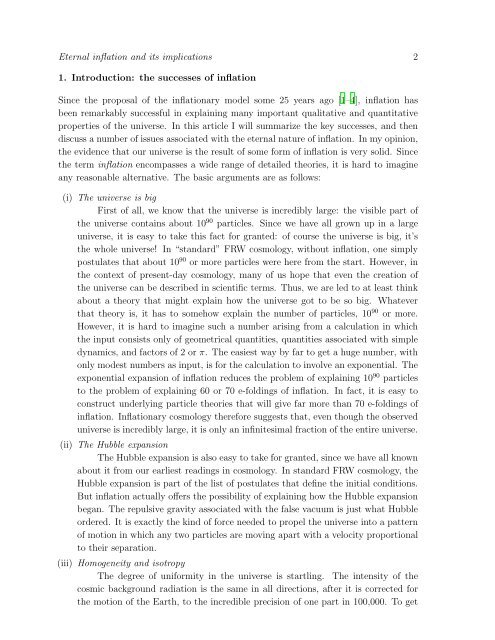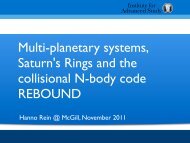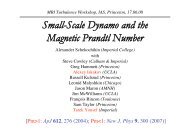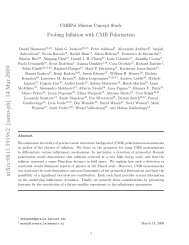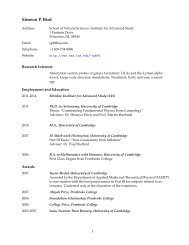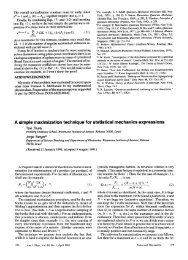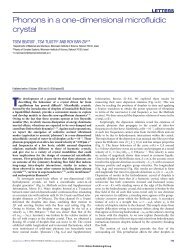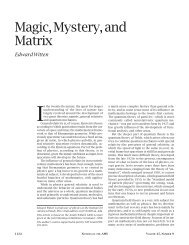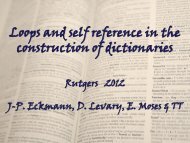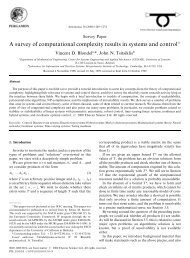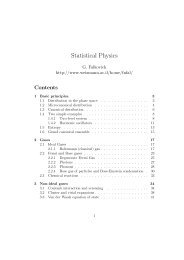Eternal inflation and its implications
Eternal inflation and its implications
Eternal inflation and its implications
Create successful ePaper yourself
Turn your PDF publications into a flip-book with our unique Google optimized e-Paper software.
<strong>Eternal</strong> <strong>inflation</strong> <strong>and</strong> <strong>its</strong> <strong>implications</strong> 2<br />
1. Introduction: the successes of <strong>inflation</strong><br />
Since the proposal of the <strong>inflation</strong>ary model some 25 years ago [1–4], <strong>inflation</strong> has<br />
been remarkably successful in explaining many important qualitative <strong>and</strong> quantitative<br />
properties of the universe. In this article I will summarize the key successes, <strong>and</strong> then<br />
discuss a number of issues associated with the eternal nature of <strong>inflation</strong>. In my opinion,<br />
the evidence that our universe is the result of some form of <strong>inflation</strong> is very solid. Since<br />
the term <strong>inflation</strong> encompasses a wide range of detailed theories, it is hard to imagine<br />
any reasonable alternative. The basic arguments are as follows:<br />
(i) The universe is big<br />
First of all, we know that the universe is incredibly large: the visible part of<br />
the universe contains about 10 90 particles. Since we have all grown up in a large<br />
universe, it is easy to take this fact for granted: of course the universe is big, it’s<br />
the whole universe! In “st<strong>and</strong>ard” FRW cosmology, without <strong>inflation</strong>, one simply<br />
postulates that about 10 90 or more particles were here from the start. However, in<br />
the context of present-day cosmology, many of us hope that even the creation of<br />
the universe can be described in scientific terms. Thus, we are led to at least think<br />
about a theory that might explain how the universe got to be so big. Whatever<br />
that theory is, it has to somehow explain the number of particles, 10 90 or more.<br />
However, it is hard to imagine such a number arising from a calculation in which<br />
the input consists only of geometrical quantities, quantities associated with simple<br />
dynamics, <strong>and</strong> factors of 2 or π. The easiest way by far to get a huge number, with<br />
only modest numbers as input, is for the calculation to involve an exponential. The<br />
exponential expansion of <strong>inflation</strong> reduces the problem of explaining 10 90 particles<br />
to the problem of explaining 60 or 70 e-foldings of <strong>inflation</strong>. In fact, it is easy to<br />
construct underlying particle theories that will give far more than 70 e-foldings of<br />
<strong>inflation</strong>. Inflationary cosmology therefore suggests that, even though the observed<br />
universe is incredibly large, it is only an infinitesimal fraction of the entire universe.<br />
(ii) The Hubble expansion<br />
The Hubble expansion is also easy to take for granted, since we have all known<br />
about it from our earliest readings in cosmology. In st<strong>and</strong>ard FRW cosmology, the<br />
Hubble expansion is part of the list of postulates that define the initial conditions.<br />
But <strong>inflation</strong> actually offers the possibility of explaining how the Hubble expansion<br />
began. The repulsive gravity associated with the false vacuum is just what Hubble<br />
ordered. It is exactly the kind of force needed to propel the universe into a pattern<br />
of motion in which any two particles are moving apart with a velocity proportional<br />
to their separation.<br />
(iii) Homogeneity <strong>and</strong> isotropy<br />
The degree of uniformity in the universe is startling. The intensity of the<br />
cosmic background radiation is the same in all directions, after it is corrected for<br />
the motion of the Earth, to the incredible precision of one part in 100,000. To get


